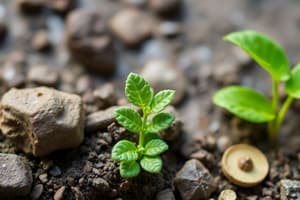Podcast
Questions and Answers
In biology and ecology, what are abiotic components?
In biology and ecology, what are abiotic components?
Abiotic components or abiotic factors are non-living chemical and physical parts of the environment that affect living organisms and the functioning of ecosystems.
How do abiotic factors affect biology as a whole?
How do abiotic factors affect biology as a whole?
Abiotic factors and the phenomena associated with them underpin biology as a whole.
Give an example of how humans can make or change abiotic factors in a species' environment.
Give an example of how humans can make or change abiotic factors in a species' environment.
For instance, fertilizers can affect a snail's habitat, or the greenhouse gases which humans utilize can change marine pH levels.
What do abiotic components include and how do they affect living organisms?
What do abiotic components include and how do they affect living organisms?
What is the distinction between resources in terms of how they are used by organisms?
What is the distinction between resources in terms of how they are used by organisms?
What are some examples of abiotic factors that can affect marine animals?
What are some examples of abiotic factors that can affect marine animals?
How can fertilizers impact a snail's habitat?
How can fertilizers impact a snail's habitat?
What are some physical conditions that can influence the growth, maintenance, and reproduction of living organisms?
What are some physical conditions that can influence the growth, maintenance, and reproduction of living organisms?
What are the two processes by which component degradation of a substance occurs?
What are the two processes by which component degradation of a substance occurs?
How do abiotic components underpin biology as a whole?
How do abiotic components underpin biology as a whole?
What are abiotic components and how do they affect living organisms?
What are abiotic components and how do they affect living organisms?
Give an example of how humans can make or change abiotic factors in a species' environment.
Give an example of how humans can make or change abiotic factors in a species' environment.
What are some examples of abiotic factors?
What are some examples of abiotic factors?
What is the distinction between resources in terms of how they are used by organisms?
What is the distinction between resources in terms of how they are used by organisms?
How can fertilizers impact a snail's habitat?
How can fertilizers impact a snail's habitat?
Flashcards are hidden until you start studying
Study Notes
Abiotic Components and Their Impact on Living Organisms
- Abiotic components are non-living factors in an ecosystem that affect living organisms, such as light, temperature, water, soil, and atmospheric gases.
- Abiotic factors can affect biology as a whole by influencing the growth, maintenance, and reproduction of living organisms.
- Humans can make or change abiotic factors in a species' environment, for example, by releasing pollutants into the air or water, altering the pH of soil, or constructing dams that change water flow.
Resources and Their Utilization by Organisms
- Resources can be distinguished based on how they are used by organisms, such as energy sources, nutrients, and habitat structures.
- Energy sources include light, heat, and chemical energy, which are used by organisms to power their metabolic processes.
- Nutrients are substances required for growth and development, such as carbon, oxygen, and essential minerals.
- Habitat structures provide a physical environment for organisms to live, feed, and breed.
Examples of Abiotic Factors Affecting Marine Animals
- Temperature changes can affect marine animals' metabolic rates, growth, and reproduction.
- Water salinity and pH levels can influence the distribution and abundance of marine species.
- Ocean currents and tides can impact the dispersal and migration patterns of marine animals.
Impact of Fertilizers on Snail Habitats
- Fertilizers can alter the pH and nutrient levels of soil, affecting the growth and reproduction of snails.
- Excessive fertilizer use can lead to eutrophication, resulting in an overgrowth of algae, which can deplete oxygen levels and harm snail populations.
Physical Conditions Affecting Living Organisms
- Temperature, light, and humidity levels can influence the growth, maintenance, and reproduction of living organisms.
- Geological features, such as topography and soil composition, can affect the distribution and abundance of species.
Decomposition Processes
- Abiotic components can undergo two types of degradation: biological decomposition (e.g., by microorganisms) and chemical decomposition (e.g., by oxidization).
Importance of Abiotic Components in Biology
- Abiotic components underpin biology as a whole by providing the environmental context in which living organisms exist and interact.
- Understanding abiotic components is essential for understanding the complex interactions within ecosystems and the impacts of human activities on the environment.
Studying That Suits You
Use AI to generate personalized quizzes and flashcards to suit your learning preferences.




